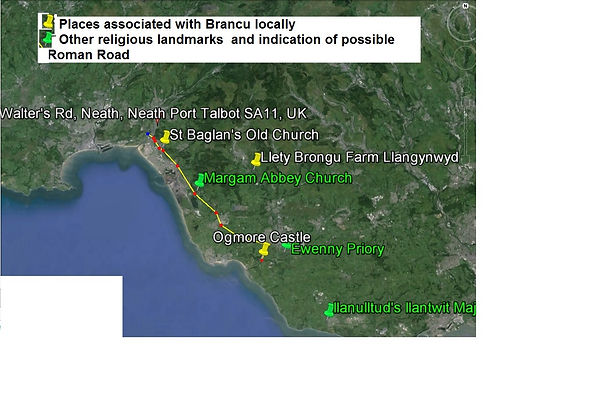
The Brancuf Stone


In 1850 a slab with a carved ringed cross in false relief was found in the old churchyard. It is inscribed +BRANCU·F[ ]; presumably the f is fecit. Dated as late 9th or early 10th century, it is known as the Brancuf Stone. It has been set into the vestry wall in St Catharine’s.
Ym 1850, darganfuwyd slab gyda chroes gylchog gerfiedig mewn ffug-gerfwedd yn yr hen fynwent. Mae wedi'i engrafu â +BRANCU·F[ ]; gellid tybio mai’r f yw fecit. Mae'r garreg wedi'i dyddio o ddiwedd y 9fed ganrif neu ddechrau'r 10fed ganrif, ac fe'i gelwir yn garreg Brancuf. Mae wedi'i gosod yn wal y festri yn Eglwys y Santes Catharine.
RCAHMW/1976, 43: `An incomplete slab with carved cross and part inscription'.
Condition:
complete , good
1: latin; interlace; tapering; bifid; curved; none; outer curv; none; n/a
geometric ribbon interlace
Westwood/1851 is quoted almost verbatim in Westwood/1879, 24.
Westwood/1879, 24: `The ornament is formed by the regular interlacing of an endless double ribbon into a Greek +, the arms being united by double ribbons, so placed as to give the head of the cross a circular outline, very much in the style of some of the fine Irish crosses. The lower limb of the cross is smaller than the others, resting on a square base, also ornamented with an interlaced design, the ribbon being double in four of the interlacements, so as to give a more symmetrical idea to the figure. I do not recollect to have met with a more simple and elegant design in any of the numerous carved stones which I have examined.'
Macalister/1949, 152, `A well-designed interlacing cross is pocked upon it'.
Nash-Williams/1950, 130, `Carved Latin wheel-cross in low relief, formed of double-beaded interlacing, embodying Stafford-knots (R.A. 262) in the arm-ends and a square of eight-cord knot-work (R.A. 638) in the stem.'
RCAHMW/1976, 43: `On the surviving part of the rectangular sandstone slab...is a ringed cross in false relief formed by double-beaded cords outlining a Greek cross with rounded angles and making squared Stafford-knots in the lower arm-ends. At the upper arm-end the cords instead of interlacing merge into a squared panel of narrow double-beaded knotwork, while at the foot the smaller knot rests on a stem in the form of a square panel of eight-cord knotwork incorporating a central cruciform break. The double-beaded arcs of the ring joining the arm-ends make circular inter-arm spaces.'
`All the letters are minuscules of the form to which the term Anglo-Saxon has ordinarily been applied, but which might with equal propriety be termed Irish or British, and which is found on many of the inscribed stones both of Ireland and Wales. The rounded form of the b, the p-like form of the r, the y or rather q-like form of the u, and the F-like form of the very distinct terminal f,[1] are all especial forms of these different minuscule letters. The invocation of the Saviour, indicated by the prefixed +, is by no means common on the monumental stones of Wales, although it occurs twice on the stone of St. Cadfan *, and several times on the cross of St. Samson at Llantwit **
* St Cadfan – associated with St Baglan both coming from Brittany together.
** St Illtud of Llantwit reputed tutor of St Baglan
One train of thought is that the wording is “preceded and followed by a small cross. The upper terminal of the second cross is bifid, and Westwood erroneously took this figure for the letter F.'” – therefore Brancu
-
The inscription is more probably + BRANCUF. The stone is broken off immediately after the F, and the full inscription must have been Brancu fecit The name would be the older *Brancum [Nash-Williams takes the name as Brancuf (ECMW. P. 130), which would be an unparalleled use of f for m so early, and is very improbable at this date.]'.
Brancu and Llety Brongu
The other three llodre names are still extant. They are listed here; none of them has produced any firm
evidence of any other kind for being the sites of ecclesiastical establishments, though one is supported by
another piece of placename evidence.
Llety Brongu was originally Llodre Brangye/Brangig, from llodre+Brangu, Brangu being a personal
name, possibly the same as the Brancu who appears on a late 9th - early 10th century cross-decorated slab at
Baglan (PRN 670w) (Pierce 1984, 487; 2002, 117-8). On the tithe map, the farm of Llety Brongu is shown as lying within an enclosure which is roughly quarter of a circle (but see section C1). For Llotrog, Pierce (2002,
17-8) notes that this is a possible adjectival form of llodre.
He further notes that in a survey of 1764 it appears as Llodrog alias St Wall (Morris 2000, 90, 93), or Seintwar in 1641, which is a borrowing from a ME
form like seintuarie (=sanctuary)
